*NURSING > HESI > Diagnostic Testing HESI prep- Adult Care Latest Exam Questions & Answers (With Rationales) (All)
Diagnostic Testing HESI prep- Adult Care Latest Exam Questions & Answers (With Rationales)
Document Content and Description Below
Diagnostic Testing HESI prep- Adult Care Latest Exam Questions & Answers (With Rationales)-A client is being prepared for a thoracentesis. The nurse should assist the client to which position for the ... procedure? a) Lying in bed on the affected side b) Lying in bed on the unaffected side c) Sims position with the head of the bed flat d) Prone with the head turned to the side and supported by a pillow - b) Lying in bed on the unaffected side Rationale: To facilitate removal of fluid from the chest, the client is positioned sitting at the edge of the bed leaning over the bedside table, with the feet supported on a stool; or lying in bed on the unaffected side with the head of the bed elevated 30 to 45 degrees. The prone and Sims positions are inappropriate positions for this procedure. The nurse is preparing to care for a client who has returned to the nursing unit following cardiac catheterization performed through the femoral artery. The nurse checks the health care provider's (HCP's) prescription and plans to allow which client position or activity following the procedure? a) Bed rest in high Fowler's position b) Bed rest with bathroom privileges only c) Bed rest with head elevation at 60 degrees d) Bed rest with head elevation no greater than 30 degrees - d) Bed rest with head elevation no greater than 30 degrees Rationale: After cardiac catheterization, the extremity into which the catheter was inserted is kept straight for 4 to 6 hours. The client is maintained on bed rest for 4 to 6 hours (time for bed rest may vary depending on the HCP's preference and on whether a vascular closure device was used) and the client may turn from side to side. The head is elevated no more than 30 degrees (although some HCPs prefer the flat position) until hemostasis is adequately achieved. A client is scheduled for a Papanicolaou (Pap) smear at the next scheduled clinic visit. The nurse provides instructions to the client regarding preparation for this test. Which statement should the nurse include in the teaching? a) The test is painless. b) Fluids are restricted on the day of the test. c) The test can be performed during menstruation. d) Vaginal douching is required 2 hours before the test. - a) The test is painless. The nurse is caring for a client after pulmonary angiography with catheter insertion via the left groin. Which assessment finding is related to an allergic reaction to the contrast medium? a) Hypothermia b) Decreased blood pressure c) Hematoma in the left groin d) Discomfort in the left groin - b) Decreased blood pressure Rationale: Signs of allergic reaction to the contrast dye include early signs such as localized itching and edema, which are followed by more severe symptoms such as respiratory distress, stridor, and decreased blood pressure. Hypothermia, discomfort in the left groin, and hematoma in the left groin are abnormal assessment findings but are not related to allergic reaction to the contrast medium. The nurse assists a health care provider in performing a liver biopsy. After the biopsy, the nurse should place the client in which position? a) Prone b) Supine c) A left side-lying position with a small pillow or folded towel under the puncture site d) A right side-lying position with a small pillow or folded towel under the puncture site - d) A right side-lying position with a small pillow or folded towel under the puncture site Rationale: After a liver biopsy, the client is assisted to assume a right side-lying position with a small pillow or folded towel under the puncture site for 3 hours. This position compresses the liver against the chest wall at the biopsy site. Therefore all other options are incorrect. A client is scheduled for a fiberoptic gastrointestinal (GI) procedure. The nurse instructs the client to remain on clear liquids the day before the test because a clear liquid diet supports which action? a) Stimulating peristalsis b) Promoting a laxative action c) Providing little or no residue d) Providing minimal calories and nutrients - c) Providing little or no residue The nurse is preparing to collect a 24-hour urine specimen from the client. Which is an inaccurate action in collecting the specimen? . a) Placing the specimen on ice or refrigerating it b) Discarding the urine specimen at the start time c) Asking the client to void, saving the specimen, and noting the start time d) Asking the client to void at the end of the collection and adding this specimen to the collection - c) Asking the client to void, saving the specimen, and noting the start time Rationale: Because the 24-hour urine is a timed, quantitative determination, it is essential to start the test with an empty bladder. The collected urine should be refrigerated or placed on ice to prevent changes in the urine. Fifteen minutes before the end of the collection time, the client should be asked to void, and this specimen is added to the collection. The nurse instructs a female client to obtain a clean-catch urine specimen for culture and sensitivity testing. Which statement by the client indicates that she understands the procedure for collecting the specimen? a) "A urine specimen will be obtained from a catheter." b) "I need to clean the labia with toilet paper and void into the sterile specimen container." c) "I should empty my bladder into a container so that the full amount of urine can be determined." d) "I need to cleanse the labia using cleansing towels, void into the toilet, and then void into the sterile specimen container." - d) "I need to cleanse the labia using cleansing towels, void into the toilet, and then void into the sterile specimen container." Rationale: Urine specimens for culture and sensitivity need to be obtained with the use of proper cleansing and voiding techniques to avoid contamination from external sources. The use of toilet paper will contaminate the specimen. The procedure described in option 3 would not provide a clean specimen. It is not necessary to obtain the specimen via a catheter. A client is scheduled for an excretory urogram. Which should the nurse expect to be prescribed as a component of preparation for this test? a) NPO status after midnight b) Administration of intravenous fluids c) Administration of a sedative before the test d) Bowel preparation to remove fecal contents - d) Bowel preparation to remove fecal contents Rationale: An excretory urogram is an invasive test that uses contrast radiopaque dye to assess the ability of the kidneys to excrete dye in the urine. Bowel preparation is necessary to permit adequate visualization of the kidneys, ureters, and bladder. Options 1, 2, and 3 usually are not components of preparation for this test. The nurse is explaining an upper gastrointestinal series to a client and provides the client with the preprocedure and postprocedure instructions. The nurse informs the client that after this procedure, the stools can be expected to remain white for what time period? a) 1 week b) 6 hours c) 8 hours d) 1 to 2 days - d) 1 to 2 days Rationale: It takes at least 12 to 24 hours for a substance to pass through the colon. One week is too long a period, and 6 to 8 hours is too short a period because of residual barium and decreased peristalsis. The nurse is planning care for a client who has just returned to the nursing unit after an oral cholecystogram. The nurse should expect to be able to delete which prescription on the client's care plan? a) Monitor hydration status. b) Assess for nausea and vomiting. c) Monitor for abdominal discomfort. d) Maintain a clear liquid diet for 72 hours. - d) Maintain a clear liquid diet for 72 hours. Rationale: The client should be able to resume the usual diet once the nurse is sure that the client's gastrointestinal (GI) function is normal. It is not necessary to keep the client on clear liquids for 72 hours after the procedure. The nurse would also assess hydration status as part of routine care for the client undergoing a GI diagnostic test. The nurse would monitor the client for complaints of GI discomfort and nausea and vomiting. The nurse is scheduling diagnostic tests for a client. Which of the diagnostic tests prescribed should be performed last? a) Barium enema b) Barium swallow c) Gallbladder series d) Oral cholecystogram - b) Barium swallow Rationale: A barium swallow should be done after a barium enema or gallbladder series to prevent the contrast used in the barium swallow from obstructing the view of other organs. It takes several days for swallowed barium to pass completely out of the gastrointestinal tract. [Show More]
Last updated: 1 year ago
Preview 1 out of 22 pages

Buy this document to get the full access instantly
Instant Download Access after purchase
Buy NowInstant download
We Accept:

Reviews( 0 )
$12.00
Can't find what you want? Try our AI powered Search
Document information
Connected school, study & course
About the document
Uploaded On
Nov 27, 2023
Number of pages
22
Written in
Additional information
This document has been written for:
Uploaded
Nov 27, 2023
Downloads
0
Views
60

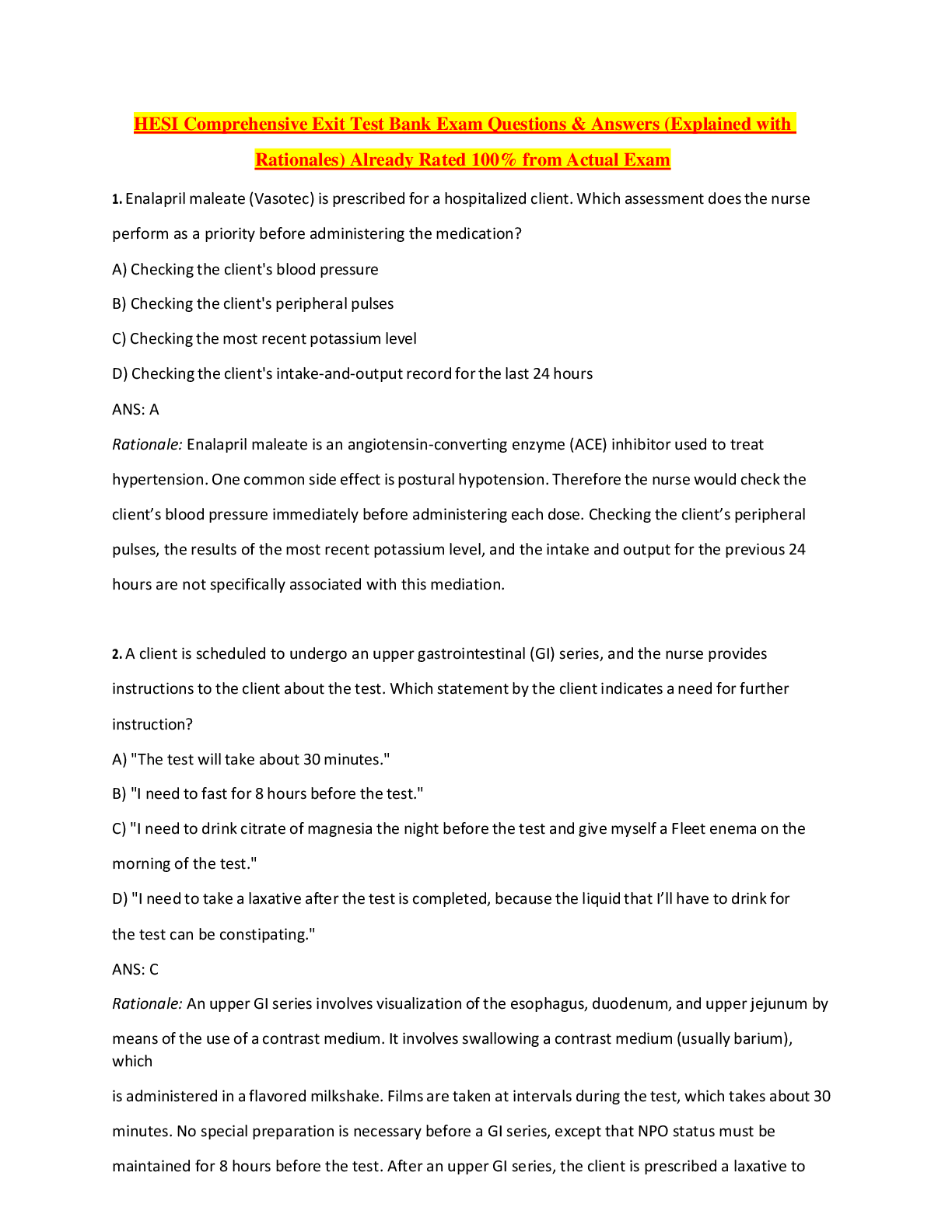
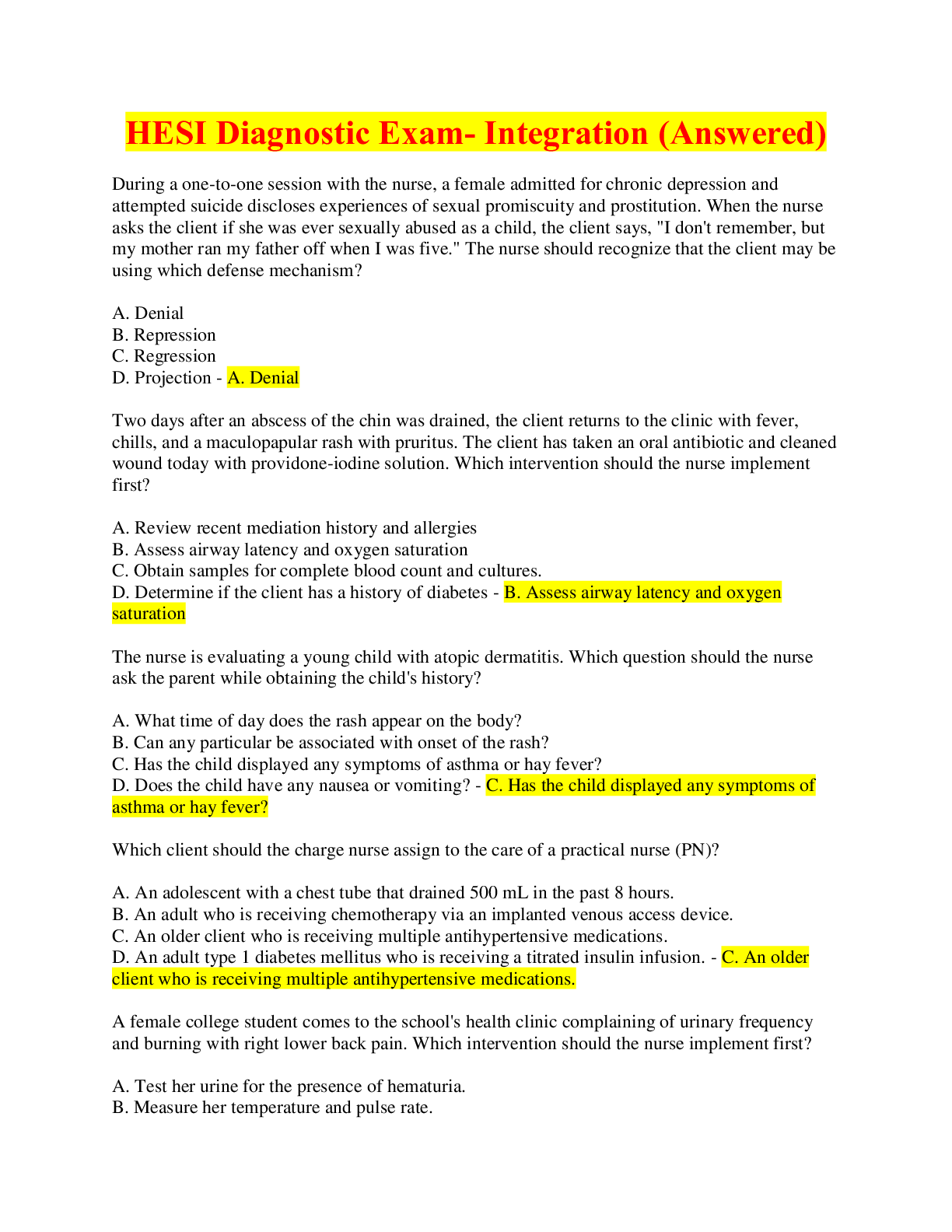






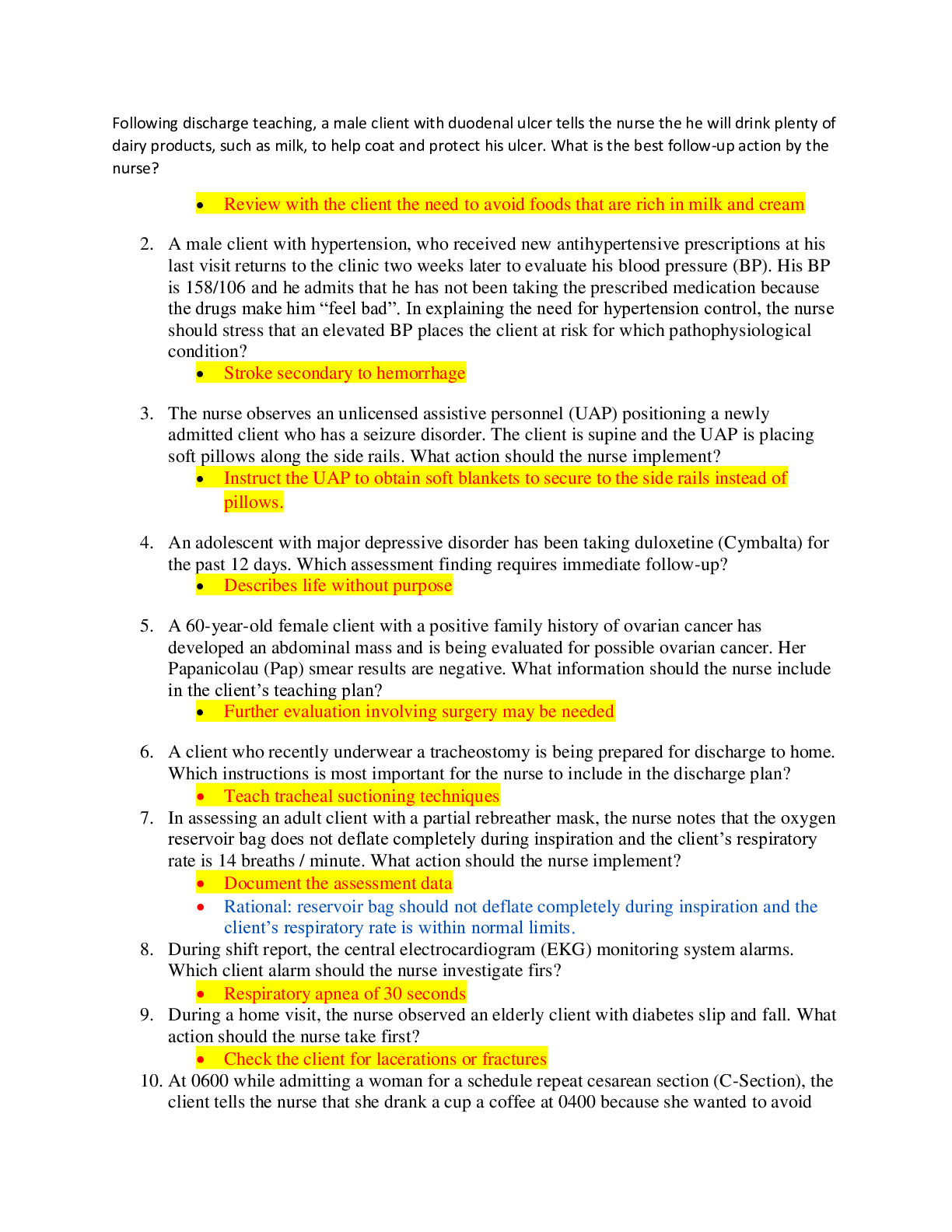


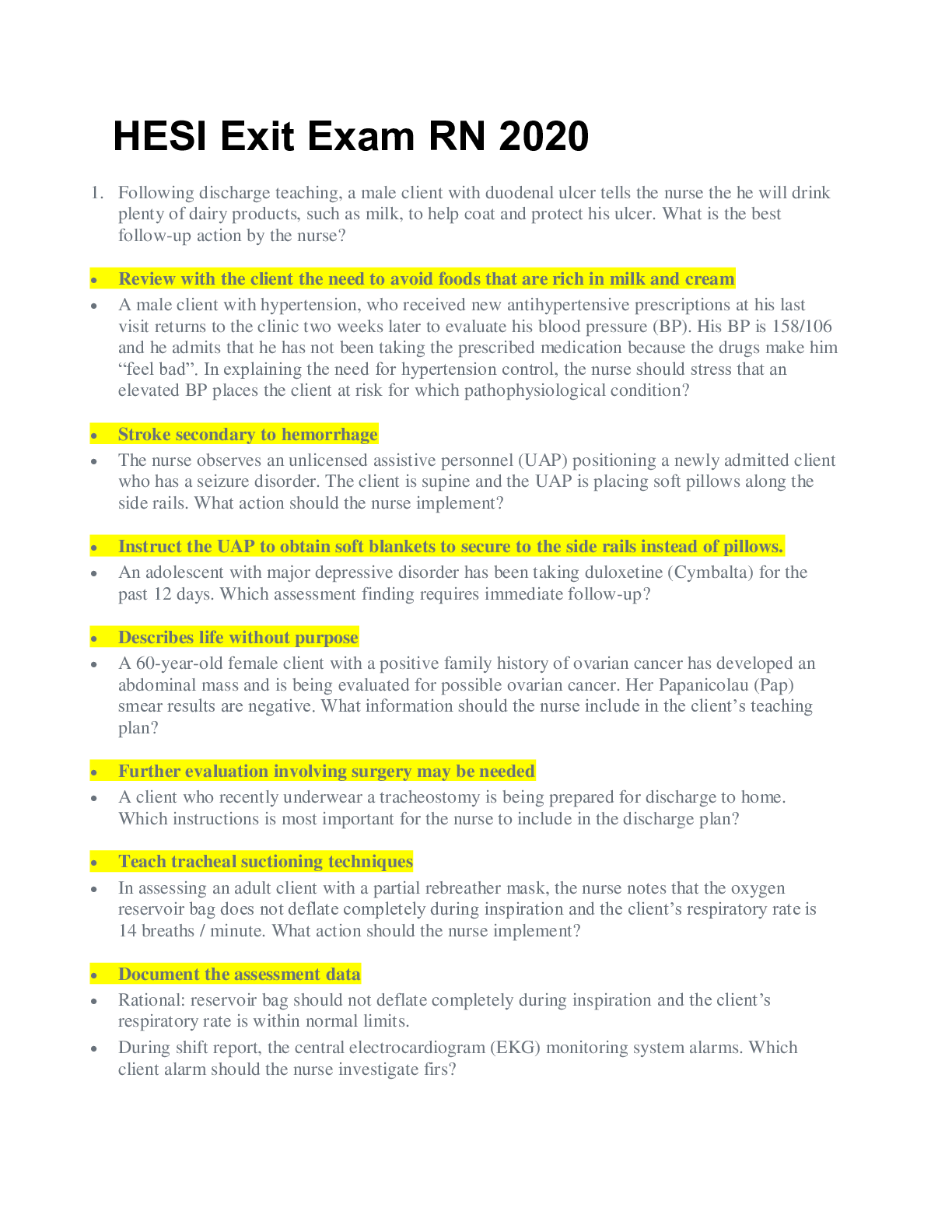
.png)

 - Over 500 Questions – Nightingale College.png)
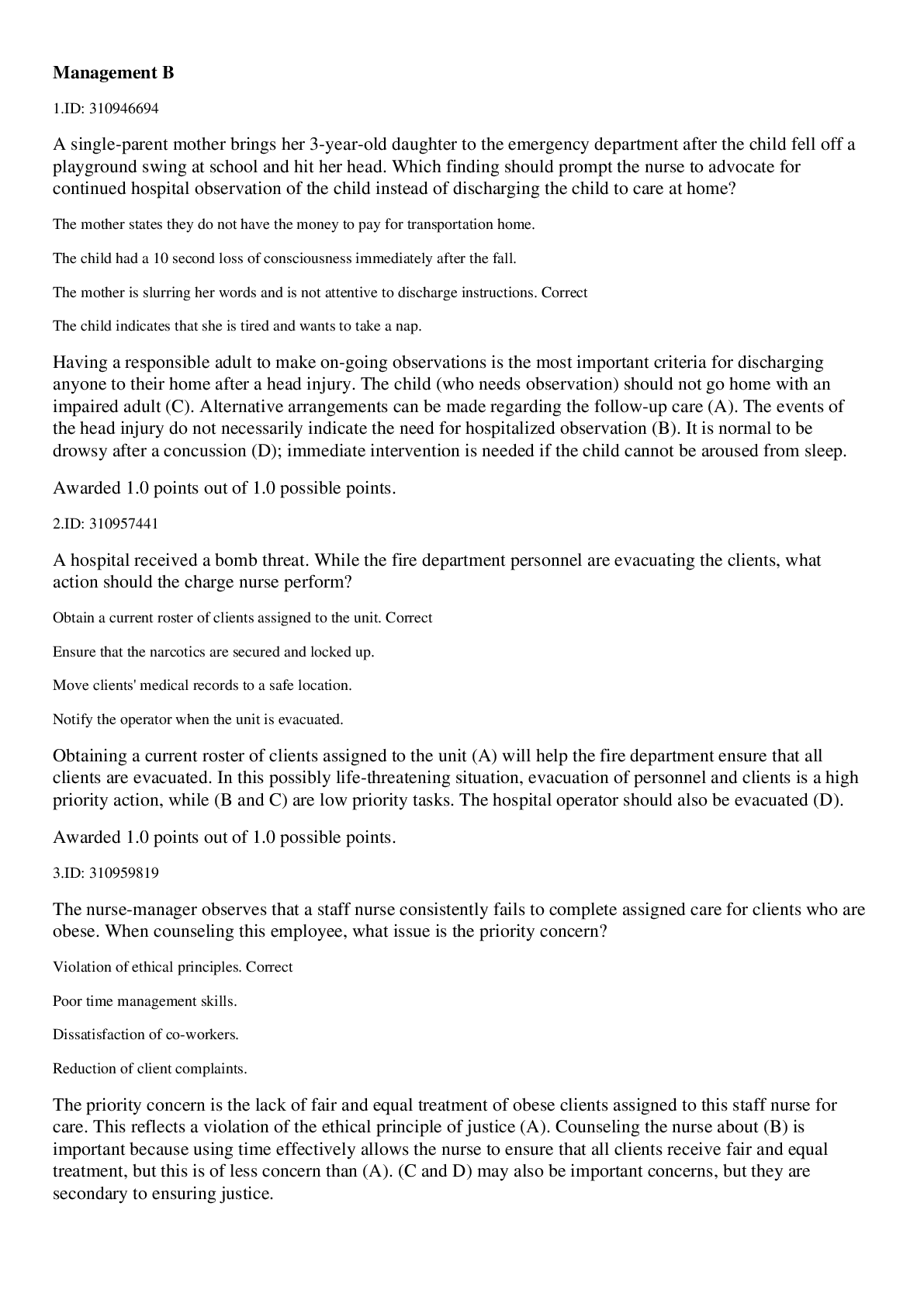
.png)
.png)
.png)
.png)




